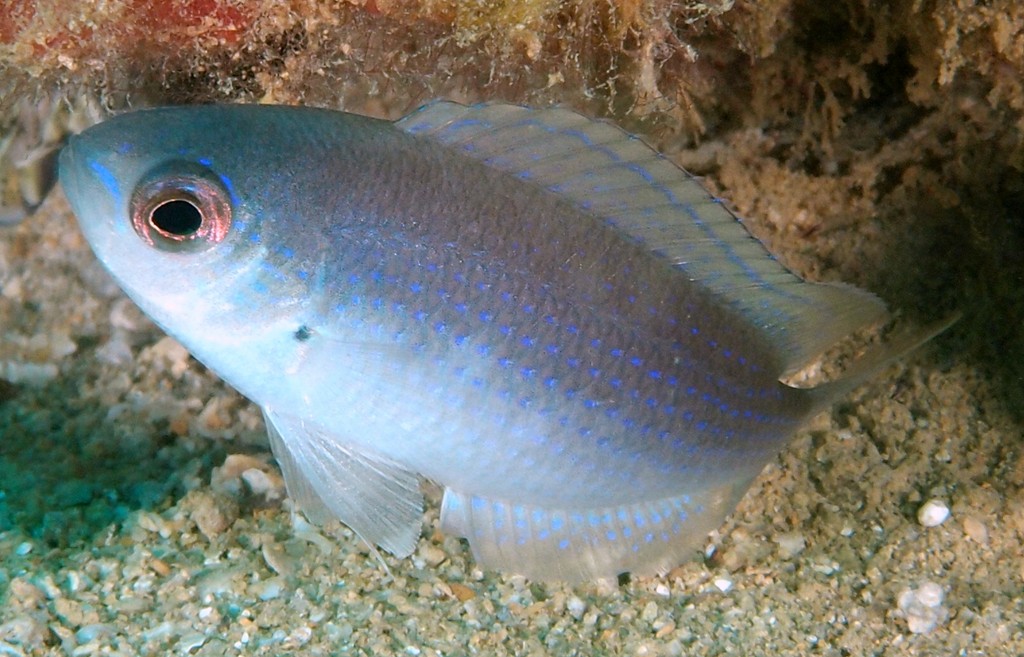PRISTOTIS OBTUSIROSTRIS - (GUNTHER, 1862)
Actinopterygii (Gigaclass) > Actinopteri (Class) > Teleostei (Subclass) > Blenniiformes (Order) > Pomacentridae (Family) > Pomacentrinae (Subfamily) > Pristotis (Genus)
Green puller, Gulf damselfish, Jerdon's damsel-fish, Jerdon's demoiselle, Roaming damsel, Spotted Damsel, Oki-suzumedai, オキスズメダイ, 台雅鱼, 海湾锯齿雀鲷,
Synonymes
Chromis virescens (Ogilby, 1922)
Daya jerdoni (Day, 1873)
Daya jerdoni fusca (McCulloch, 1921)
Pomacentrus dolii (MacLeay, 1881)
Pomacentrus jerdoni (Day, 1873)
Pomacentrus obtusirostris (Günther, 1862)
Pristotis jerdoni (Day, 1873)
Pristotis judithae (Tyler, 1966)
-----------------------------
Description
Dorsal spines (total): 13; Dorsal soft rays (total): 12-13; Anal spines: 2; Anal soft rays: 12-14. The height of the body is two-sevenths of the total length; Snout obtuse, much shorter than the diameter of the orbit, the width of which is more than that of the interorbital space. There are only six small incisors anteriorly in the upper jaw, and eight in the lower, the lateral teeth being very small. Preorbital very narrow and not serrated; Preoperculum finely serrated; Operculum with two spines. The scales on the upper side of the head do not advance to the front margin of the orbit. Of the dorsal spines the fourth, fifth and sixth are the longest, the posterior ones being a little shorter; The soft dorsal and anal and the caudal lobes are produced into a point. Max. length: 14.0 cm TL. Depth range: 0 - 104 m, usually: 2 - 80 m.
Green puller, Gulf damselfish, Jerdon's damsel-fish, Jerdon's demoiselle, Roaming damsel, Spotted Damsel, Oki-suzumedai, オキスズメダイ, 台雅鱼, 海湾锯齿雀鲷,
Synonymes
Chromis virescens (Ogilby, 1922)
Daya jerdoni (Day, 1873)
Daya jerdoni fusca (McCulloch, 1921)
Pomacentrus dolii (MacLeay, 1881)
Pomacentrus jerdoni (Day, 1873)
Pomacentrus obtusirostris (Günther, 1862)
Pristotis jerdoni (Day, 1873)
Pristotis judithae (Tyler, 1966)
-----------------------------
Description
Dorsal spines (total): 13; Dorsal soft rays (total): 12-13; Anal spines: 2; Anal soft rays: 12-14. The height of the body is two-sevenths of the total length; Snout obtuse, much shorter than the diameter of the orbit, the width of which is more than that of the interorbital space. There are only six small incisors anteriorly in the upper jaw, and eight in the lower, the lateral teeth being very small. Preorbital very narrow and not serrated; Preoperculum finely serrated; Operculum with two spines. The scales on the upper side of the head do not advance to the front margin of the orbit. Of the dorsal spines the fourth, fifth and sixth are the longest, the posterior ones being a little shorter; The soft dorsal and anal and the caudal lobes are produced into a point. Max. length: 14.0 cm TL. Depth range: 0 - 104 m, usually: 2 - 80 m.
Color
Light-yollowish-olive (in spirits), dorsal fin blackish; A deep-black spot superiorly in the axil of the pectoral.
Etymology
Pristotis: from Greek, pristis = saw + from Greek, ous, otis = ear.
obtusirostris: from Latin, obtūsus = blunt, dull, obtuse + from Latin, rostrum = beak, proboscis, trunk. Named for its blunt snout.
Distribution
Red Sea; Indo-West Pacific: Persian Gulf east to Philippines and New Guinea, north to Ryukyu Islands (Japan), south to Western Australia, southern New South Wales (Australia) and New Caledonia.
Biology
Adults are found mainly along continental margins rather than truly oceanic areas. Inhabits flat sandy or rubble bottoms around patch reefs of lagoons and trawling grounds. Adults often seen in small groups out in the open on sandy substrate, swimming well-above the bottom and unlike other damselfishes rely on speed to get away from predators rather than diving into the shelter or reefs or burrow. Juveniles often shallow estuaries, but adults mainly in deeper water offshore. Oviparous, distinct pairing during breeding. Eggs are demersal and adhere to the substrate. Males guard and aerate the eggs.
Similar species
Etymology
Pristotis: from Greek, pristis = saw + from Greek, ous, otis = ear.
obtusirostris: from Latin, obtūsus = blunt, dull, obtuse + from Latin, rostrum = beak, proboscis, trunk. Named for its blunt snout.
Original description: Pomacentrus obtusirostris Günther, 1862 - Type locality: no locality stated.
Distribution
Red Sea; Indo-West Pacific: Persian Gulf east to Philippines and New Guinea, north to Ryukyu Islands (Japan), south to Western Australia, southern New South Wales (Australia) and New Caledonia.
Biology
Adults are found mainly along continental margins rather than truly oceanic areas. Inhabits flat sandy or rubble bottoms around patch reefs of lagoons and trawling grounds. Adults often seen in small groups out in the open on sandy substrate, swimming well-above the bottom and unlike other damselfishes rely on speed to get away from predators rather than diving into the shelter or reefs or burrow. Juveniles often shallow estuaries, but adults mainly in deeper water offshore. Oviparous, distinct pairing during breeding. Eggs are demersal and adhere to the substrate. Males guard and aerate the eggs.
Similar species
Pristotis cyanostigma (Rüppell, 1838) - Reported from Red Sea; northwestern Indian Ocean: Gulf of Aden.
Teixeirichthys jordani (Rutter, 1897) - Reported from Red Sea; Indo-West Pacific: Seychelles, Mozambique Channel, Madagascar; northern Australia; People's Republic of China and Taiwan to southern Japan. The morphological difference between these two is the number of lateral line scales (20 in Pristotis vs 30 in Teixerichthys).
